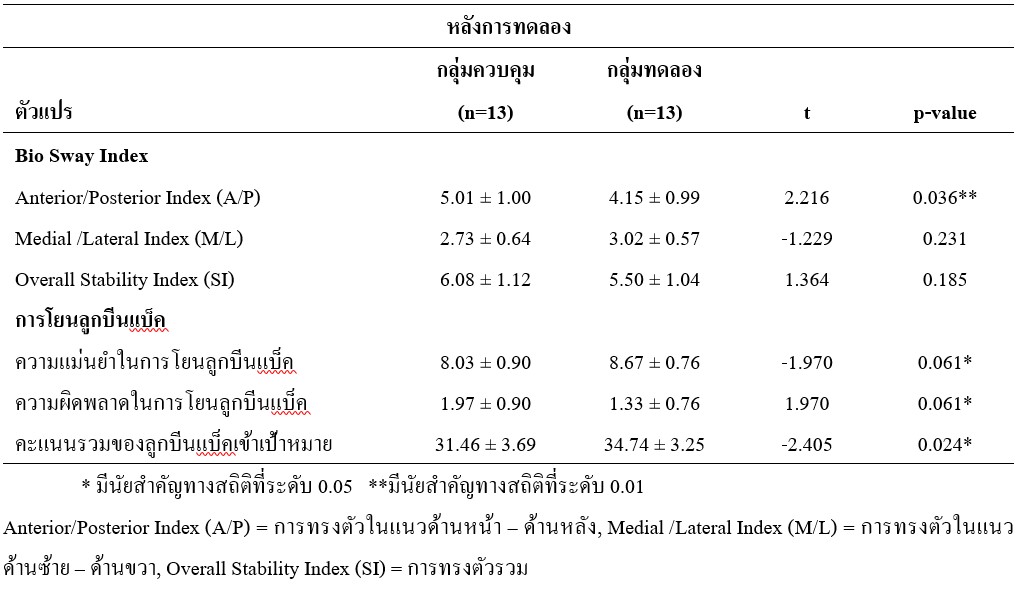EFFECTS OF PILATES TRAINING ON DUAL TASK PERFORMANCE OF UNIVERSITY MALE FUTSAL PLAYERS
Main Article Content
Abstract
Purpose: This research was aimed to study the effects of complementary Pilates training in enhancing dual-task performance in male university futsal players.
Methods: Samples were twenty six university male futsal players, aged 18 to 25 years, randomly sampled equally into two groups, namely, Control Group (CG, n = 13) which was subject to normal futsal training program, and Pilates Group (PG, n = 13) which was subject to complementary one-hour Pilates training session twice a week in addition to normal futsal training for six weeks. Basic physiological parameters and dual-task performance of both groups were statistically compared before and after training using Paired-Samples T Test and Independent-Samples T Test at 0.05 level of significance.
Results: It was found that CG exhibited significantly higher bio sway index with lesser beanbag throwing accuracy than PG during performing motor-motor dual-task by throwing bean bags while single leg standing on an unstable platform of bio sway equipment. And that during performing cognitive-motor dual-task by counting backwards by seven (Serial sevens) while single leg standing on an unstable platform, CG exhibited significantly lesser correctness than PG after six-week training at 0.05 level of significance.
Conclusion: This study suggested that complementary Pilates training could enhance dynamic balance capability, beanbag throwing accuracy, and counting backwards by seven correctness under dual-task conditions as evidences in PG compared to those of CG. Therefore complementary Pilates training is an alternative technique to develop dual-task performance in university male futsal players, as well as extensible to other athletes.
Article Details

This work is licensed under a Creative Commons Attribution-NonCommercial-NoDerivatives 4.0 International License.
References
Alexis Lion, Rosario S. Spada, Gilles Bosser, Gerome C. Gauchard, Guido Anello, Paolo Bosco, Santa Calabrese, Antonella Iero, Giuseppe Stella, Maurizio Elia, and Philippe P. Perrin (2014). “Postural first” principle when balance is challenged in elderly people. International Journal of Neuroscience, 124(8), 558-566.
Bloem, B. R., Grimbergen, Y. A. M., Dijk, J. G. v., & Munneke, M. (2006). The ‘‘posture second’’ strategy- A review of wrong priorities in Parkinson’s disease. Journal of the Neurological Sciences, 248(1-2), 196-204.
Chong, R. K. Y., Mills, B., Dailey, L., Lane, E., Smith, S., & Lee, K.-H. (2010). Specific interference between a cognitive task and sensory organization for stance balance control in healthy young adults: Visuospatial effects. Neuropsychologia, 48(9), 2709-2718.
Eur-aree, V. (2015). Effects of Pilates Exercise on the Core Muscle Control and the Shotting Performance Among Rifle Shooters. (Master), Chiangmai University, Chiangmai.
Franchignoni, F., Martignoni, E., Ferrieroa, G., & Pasetti, C. (2005). Balance and fear of falling in Parkinson’s disease. Parkinsonism & Related Disorders, 11(7), 427–433.
Gillain, S., Warzee, E., Lekeu, F., Wojtasik, V., Maquet, D., Croisier, J.-L., Petermans, J. (2009). The value of instrumental gait analysis in elderly healthy, MCI or Alzheimer’s disease subjects and a comparison with other clinical tests used in single and dual-task conditions. Annals of Physical and Rehabilitation Medicine, 52(6), 453–474.
Javad, S., Aliasghar. N. (2018). The effect of integrative neuromuscular training on postural control of children with autism spectrum. Neuro Neurosurg, 1(2), 1-2.
Montero-Odasso, M., Muir, S. W., & Speechley, M. (2012). Dual-Task Complexity Affects Gait in People With Mild Cognitive Impairment: The Interplay Between Gait Variability, Dual Tasking, and Risk of Falls. Archives of Physical Medicine and Rehabilitation, 93(2), 293–299.
Moore, R., Bullough, S., Goldsmith, S., & Edmondson, L. (2014). A Systematic Review of Futsal Literature. American Journal of Sports Science and Medicine, 2(3), 108-116.
Pashler, H. (1994). Dual-task interference in simple tasks: Data and theory. Psychological Bulletin, 116(2), 220–244.
Preeti, Kalra, s., Yadav, J., & Pawaria, S. (2019). Effect of Pilates on Lower Limb Strength, Dynamic Balance, Agility and Coordination Skills in Aspiring State Level Badminton Players. Journal of Clinical and Diagnostic Research, 13(7), YC01-YC06.
Spildooren, J., Vercruysse, S., Desloovere, K., Vandenberghe, W., Kerckhofs, E., & Nieuwboer, A. (2010). Freezing of gait in Parkinson’s disease: The impact of dual-tasking and turning. Movement Disorders, 25(15), 2563–2570.
Strouwen, C., Molenaar, E. A. L. M., Muenks, L., Broeder, S., Ginis, P., Bloem, B. R., Heremans, E. (2019). Determinants of Dual-Task Training Effect Size in Parkinson Disease. Journal of Neurologic Physical Therapy, 43(1), 3–11.
Tania Patricia A., Filipa Manuel S. (2011). Influence of pilates training on muscular strength and flexibility in dancers. Motriz, Rio Claro, 17(4), 660-666
Taylor, M. E., Delbaere, K., Mikolaizak, A. S., Lord, S. R., & Close, J. C. T. (2013). Gait parameter risk factors for falls under simple and dual task conditions in cognitively impaired older people. Gait & Posture, 37(1), 126–130.
Wang, C., Kennedy, D. M., J. B. B., & Shea, C. H. (2013). A guide to performing difficult bimanual coordination tasks: just follow the yellow brick road. Experimental Brain Research, 230(1), 31–40.


